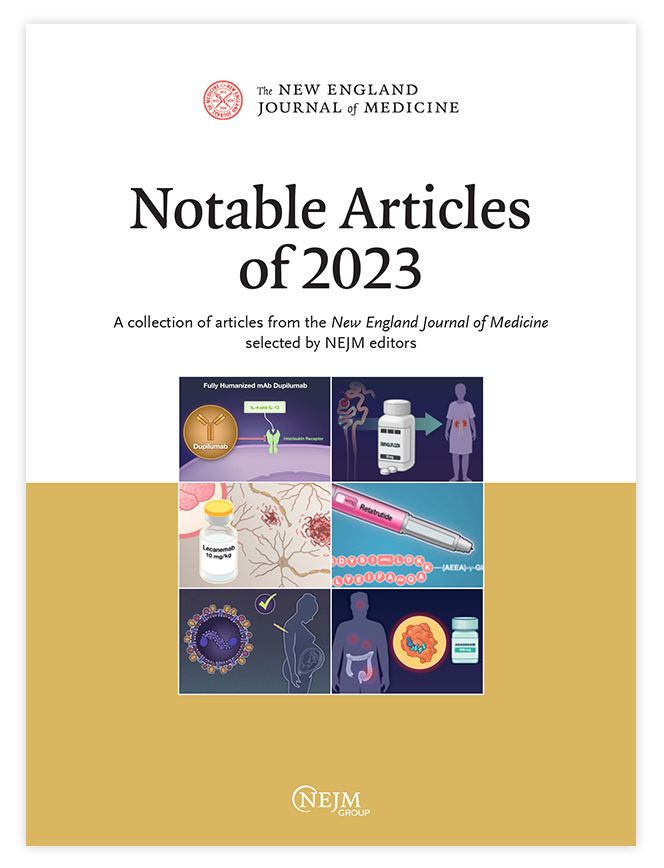Nerandomilast在特发性肺纤维化患者中的应用。
IF 96.2
1区 医学
Q1 MEDICINE, GENERAL & INTERNAL
引用次数: 0
摘要
nerandomilast (BI 1015550)是一种口服磷酸二酯酶4B抑制剂,具有抗纤维化和免疫调节作用。在一项涉及特发性肺纤维化患者的2期试验中,nerandomilast治疗在12周内稳定了肺功能。方法:在这项3期双盲试验中,我们以1:1:1的比例随机分配特发性肺纤维化患者,接受尼兰多司特18 mg每日2次、尼兰多司特9 mg每日2次或安慰剂,并根据背景抗纤维化治疗(尼达尼布或吡非尼酮vs无)进行分层。主要终点是第52周用力肺活量(FVC)相对于基线的绝对变化,以毫升计。结果共1177例患者接受随机分组,其中77.7%的患者在入组时正在服用尼达尼布或吡非尼酮。52周时,尼兰多米拉斯特18 mg组FVC的调整平均变化为-114.7 ml(95%可信区间[CI], -141.8至-87.5),尼兰多米拉斯特9 mg组为-138.6 ml (95% CI, -165.6至-111.6),安慰剂组为-183.5 ml (95% CI, -210.9至-156.1)。nerandomilast 18mg组与安慰剂组的校正差异为68.8 ml (95% CI, 30.3 ~ 107.4;P<0.001), nerandomilast 9 mg组与安慰剂组的校正差异为44.9 ml (95% CI, 6.4 ~ 83.3;p = 0.02)。尼兰莫司特组中最常见的不良事件是腹泻,18毫克组为41.3%,9毫克组为31.1%,而安慰剂组为16.0%。严重不良事件在各试验组之间是平衡的。结论:在特发性肺纤维化患者中,在52周的时间内,nerandomilast治疗的FVC下降幅度小于安慰剂。(勃林格殷格翰公司资助;FIBRONEER-IPF ClinicalTrials.gov编号:NCT05321069)。本文章由计算机程序翻译,如有差异,请以英文原文为准。
Nerandomilast in Patients with Idiopathic Pulmonary Fibrosis.
BACKGROUND
Nerandomilast (BI 1015550) is an orally administered preferential inhibitor of phosphodiesterase 4B with antifibrotic and immunomodulatory effects. In a phase 2 trial involving patients with idiopathic pulmonary fibrosis, treatment with nerandomilast stabilized lung function over a period of 12 weeks.
METHODS
In this phase 3, double-blind trial, we randomly assigned patients with idiopathic pulmonary fibrosis in a 1:1:1 ratio to receive nerandomilast at a dose of 18 mg twice daily, nerandomilast at a dose of 9 mg twice daily, or placebo, with stratification according to background antifibrotic therapy (nintedanib or pirfenidone vs. none). The primary end point was the absolute change from baseline in forced vital capacity (FVC), measured in milliliters, at week 52.
RESULTS
A total of 1177 patients underwent randomization, of whom 77.7% were taking nintedanib or pirfenidone at enrollment. Adjusted mean changes in FVC at week 52 were -114.7 ml (95% confidence interval [CI], -141.8 to -87.5) in the nerandomilast 18-mg group, -138.6 ml (95% CI, -165.6 to -111.6) in the nerandomilast 9-mg group, and -183.5 ml (95% CI, -210.9 to -156.1) in the placebo group. The adjusted difference between the nerandomilast 18-mg group and the placebo group was 68.8 ml (95% CI, 30.3 to 107.4; P<0.001), and the adjusted difference between the nerandomilast 9-mg group and the placebo group was 44.9 ml (95% CI, 6.4 to 83.3; P = 0.02). The most frequent adverse event in the nerandomilast groups was diarrhea, reported in 41.3% of the 18-mg group and 31.1% of the 9-mg group, as compared with 16.0% in the placebo group. Serious adverse events were balanced across trial groups.
CONCLUSIONS
In patients with idiopathic pulmonary fibrosis, treatment with nerandomilast resulted in a smaller decline in the FVC than placebo over a period of 52 weeks. (Funded by Boehringer Ingelheim; FIBRONEER-IPF ClinicalTrials.gov number, NCT05321069.).
求助全文
通过发布文献求助,成功后即可免费获取论文全文。
去求助
来源期刊

New England Journal of Medicine
医学-医学:内科
CiteScore
145.40
自引率
0.60%
发文量
1839
审稿时长
1 months
期刊介绍:
The New England Journal of Medicine (NEJM) stands as the foremost medical journal and website worldwide. With an impressive history spanning over two centuries, NEJM boasts a consistent publication of superb, peer-reviewed research and engaging clinical content. Our primary objective revolves around delivering high-caliber information and findings at the juncture of biomedical science and clinical practice. We strive to present this knowledge in formats that are not only comprehensible but also hold practical value, effectively influencing healthcare practices and ultimately enhancing patient outcomes.
 求助内容:
求助内容: 应助结果提醒方式:
应助结果提醒方式:


